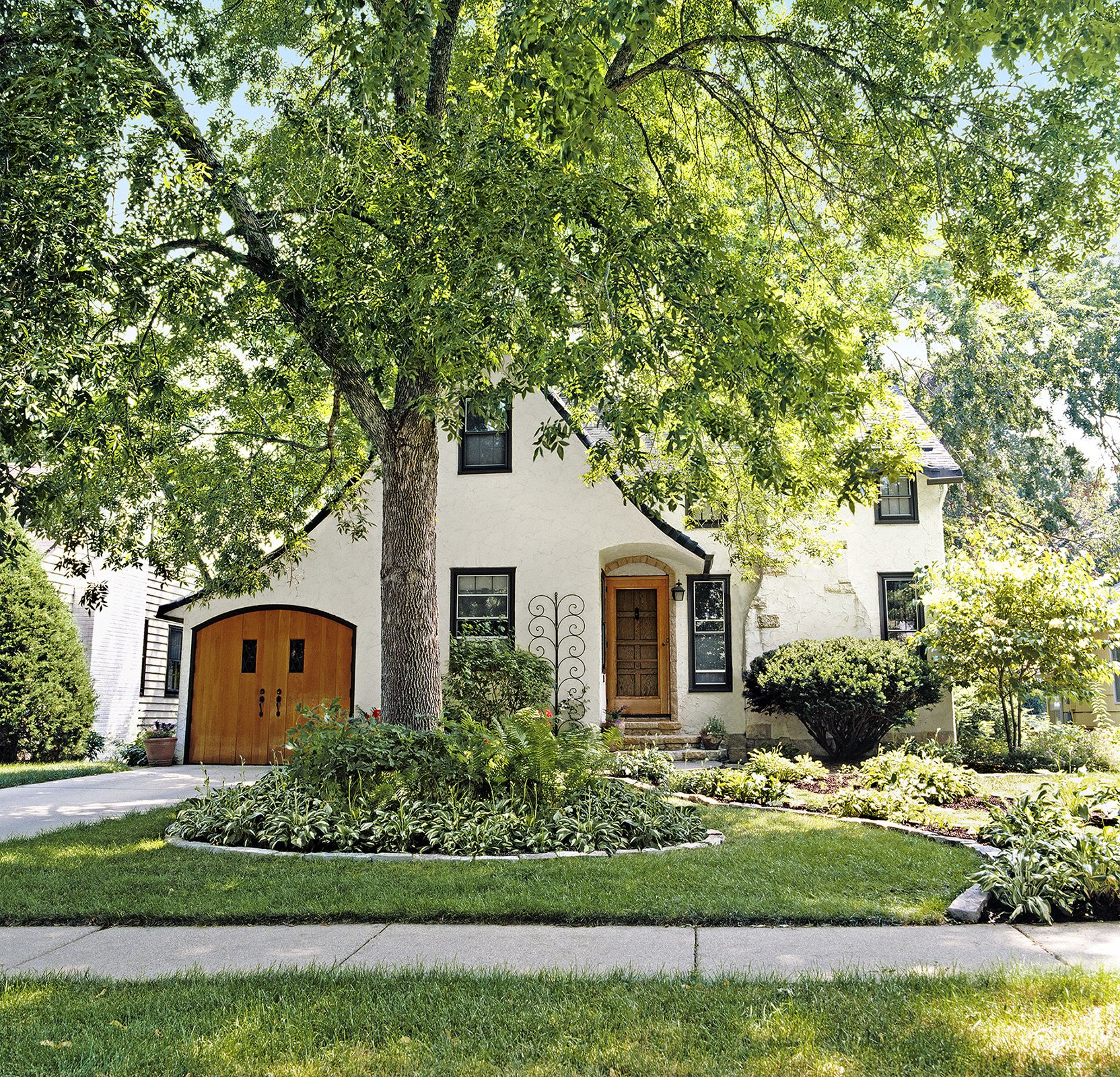
Owning a house means putting down roots, and nothing underscores that notion like planting a large tree to shade your home and yard. Read on for our guide to selecting, planting, and caring for a shade tree that will grow straight and tall—and enrich the landscape for generations to come.
What Is a Shade Tree?
A shade tree is a large, deciduous, or evergreen tree with a broad canopy that provides significant shade. These trees typically reach heights of 50 feet or more at maturity, with spreading branches that create a cooling umbrella effect. Shade trees are characterized by their ability to block sunlight, reduce temperatures, and create comfortable outdoor spaces.
Why Plant a Shade Tree?
Trees such as oaks, elms, maples, and beeches can live for a century—as you watch a shade tree grow, it will start to feel like a member of the family. There are practical reasons to put in one of these trees, too. Their deeper roots reduce the likelihood of buckling pavement, and their strong branches are less prone than spindlier specimens’ to break under stress from wind or snow.
Environmental Benefits of Shade Trees
Shade trees can improve our environment. They act as natural air purifiers, absorbing carbon dioxide and releasing oxygen. Their extensive root systems help prevent soil erosion and improve water quality by filtering runoff. Additionally, shade trees provide habitats for various wildlife, supporting local ecosystems and biodiversity.
Economic Advantages of Planting Shade Trees
The economic benefits of shade trees are substantial. Properly placed shade trees can reduce home cooling costs during hot summer months. They also increase property values, with mature trees boosting curb appeal and potentially raising home value. Moreover, shade trees can extend the life of paved surfaces by reducing heat-related damage.
Top Shade Tree Species for Your Landscape
Choosing the right shade tree for your property involves considering various factors, including climate, space, and personal preferences. Here are some recommended species to consider for different needs and regions.
Deciduous Shade Trees
Deciduous trees lose their leaves in fall, providing shade in summer and allowing sunlight through in winter. Some popular deciduous shade trees include:
- White oak (Quercus alba): A majestic tree with a broad, rounded canopy and lobed leaves that turn brilliant colors in fall
- Red maple (Acer rubrum): Known for its fast growth and vibrant red fall foliage
- American beech (Fagus grandifolia): Features smooth, light gray bark and a wide-spreading crown
- ‘Valley Forge’ elm (Ulmus americana ‘Valley Forge’): A disease-resistant cultivar with the classic vase-shaped elm form
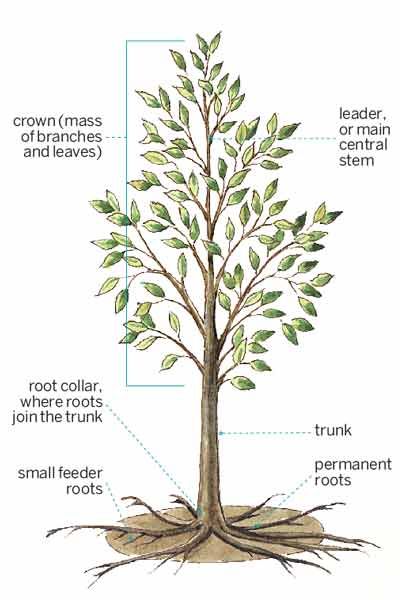
Evergreen Shade Trees
Evergreen trees maintain their foliage year-round, offering consistent shade and privacy. Some excellent evergreen shade trees include:
- Southern magnolia (Magnolia grandiflora): Features glossy, dark green leaves and fragrant white flowers
- Live oak (Quercus virginiana): A sprawling, majestic tree well-suited to warmer climates
- Eastern red cedar (Juniperus virginiana): A drought-tolerant evergreen with a pyramidal shape
Fast-Growing Shade Trees
For those seeking quicker results, fast-growing shade trees can provide relatively rapid coverage. Some options include:
- Tulip poplar (Liriodendron tulipifera): A tall, straight tree with distinctive leaves and yellow-green flowers
- River birch (Betula nigra): Features attractive peeling bark and a graceful, multi-trunked form
- Freeman maple (Acer x freemanii): A hybrid maple known for its rapid growth and fall color
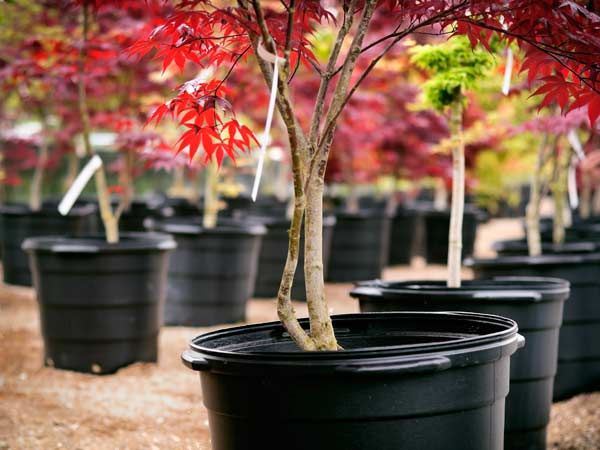
How To Choose the Right Shade Tree for Your Property
Selecting the ideal shade tree requires careful consideration of your specific landscape conditions and goals.
Assessing Your Space and Climate
Before choosing a shade tree, evaluate your available space and local climate. Consider the tree’s mature size, ensuring it has room to grow without interfering with structures or power lines. Also, remember to research your USDA Hardiness Zone and choose trees well-suited to your region’s temperature range and precipitation levels.
Considering Tree Size and Growth Rate
Match the tree’s size and growth rate to your landscape needs. A typical 55-foot-deep backyard can accommodate one large shade tree, planted at least 20 feet from the house. For smaller yards, consider medium-sized trees that reach 30–40 feet at maturity. Fast-growing trees provide quicker shade but may have shorter lifespans or weaker wood.
Evaluating Maintenance Requirements
Consider the long-term care needs of different tree species. Some trees require regular pruning, while others are more low-maintenance. When making your selection, factor in leaf litter cleanup, potential fruit or seed drop, and susceptibility to pests or diseases.
Proper Planting Techniques for Shade Trees
Correct planting can support the long-term health and success of your shade tree. Following proper techniques ensures your tree gets off to the best possible start.
Best Time To Plant Shade Trees
The ideal planting time for shade trees is typically in spring or early fall. These seasons provide moderate temperatures and adequate rainfall, allowing trees to establish strong root systems before extreme weather sets in. Plant bare-root trees in early spring only.
Buying Shade Tree Basics
Follow the tips below when shopping for your shade tree.
Potted Trees
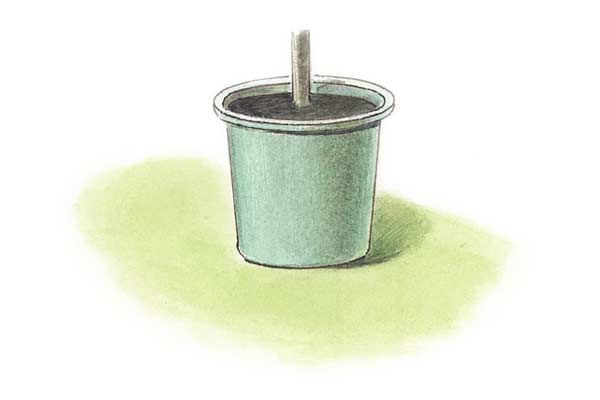
For convenience, many homeowers buy three- to five-year-old trees sold in 15-gallon pots at nurseries or home centers. To inspect one, gently slip the tree from the pot—a thick, solid mass of circling roots is a bad sign. Also, if the tree’s root collar is buried, don’t buy it.
Bare Root Options
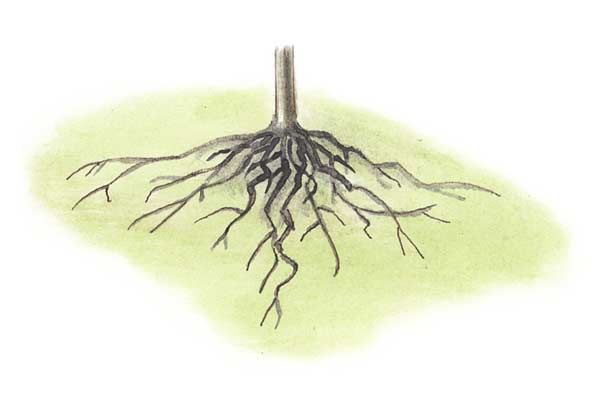
Field-grown, dug up while dormant at about one year old, then shipped, small bare-root trees can be a money-saving option. Look for multiple small, fibrous roots that are moist but not moldy. Plant within 72 hours or keep in a bucket of water until ready to plant.
Ball and Burlap
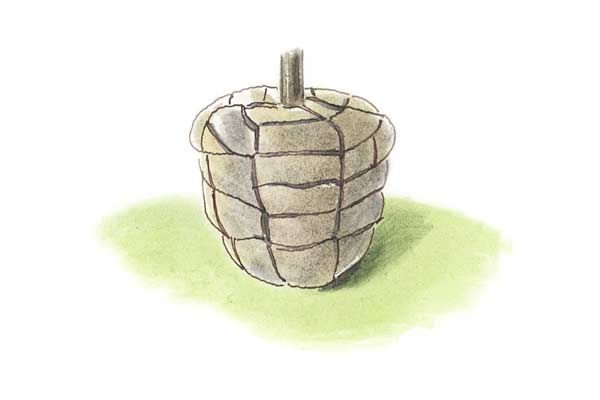
Mature, field-grown trees are dug up with soil intact, then wrapped with burlap and sold at nurseries. Check for a strong leader and a firm root ball—if the burlap is torn, roots might be broken. The root ball should be 10 to 12 times the caliper (trunk diameter), measured 6 inches above the root collar.
Plant It Right
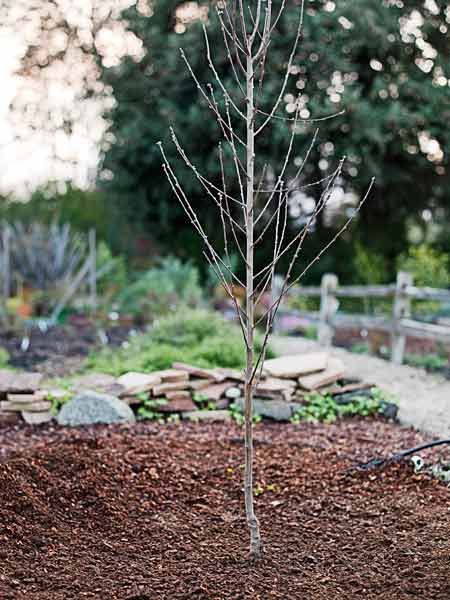
Roots spread outward, so a wide, shallow hole that allows the root collar to sit 1 to 3 inches above the soil is best.
Potted trees: Dig a hole with sides that flare outward, three times the width of the container. Carefully slide the tree from the pot. Prune any circling roots with four vertical slices along the sides of the root ball. Add soil, keeping the root collar above the hole, and water.
Bare-root trees: Soak overnight, then clip any damaged roots. Dig a hole 3 feet wide and 1 foot deep, mounding soil in the center so that the root collar sits above grade. Flare roots over the mound and fill in with soil. Water once to settle the soil, and water again.
Ball-and-burlap trees: Dig a hole as deep as the root ball and five times wider to encourage rapid rooting. Move the tree into place. Add soil so that the root collar is above the top of the hole. Remove any wire, twine, and burlap. Fill with soil and water thoroughly.
Give It Room To Grow
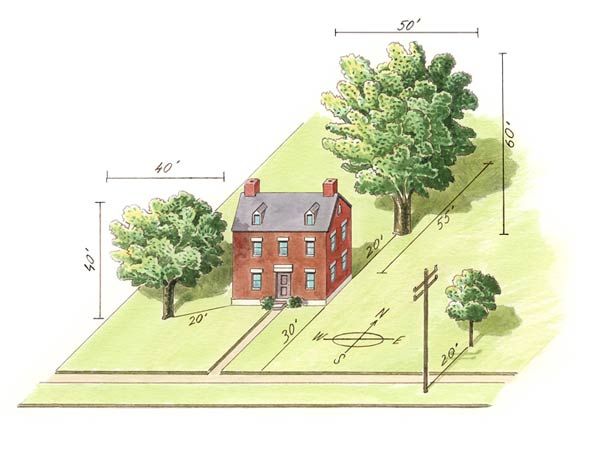
Too big a tree in too little space is an all too common problem. A tree that’s oversize for its site can damage a house’s roof or foundation, impinge on power lines, and encroach on a neighboring property. Carefully consider a specimen’s size at maturity—and believe that it will grow that big.
A typical 55-foot-deep backyard can accommodate one large shade tree, planted at least 20 feet (or about half the width of its mature canopy) from the house and 5 feet from the sidewalk. In a typical front or side yard, about 30 feet deep, select a medium-size tree no taller than 40 feet and plant it at least 20 feet from a house’s foundation. Around power lines, stick to a small tree, under 25 feet tall.
Maintaining Your Shade Tree for Optimal Health
Proper care ensures your shade tree remains healthy and beautiful for years to come. With a consistent care routine, your tree will thrive and enhance your landscape.
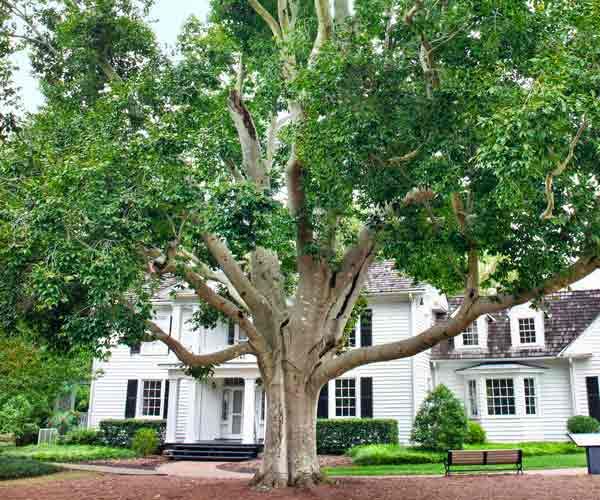
Watering and Fertilizing Tips
Water deeply and infrequently to encourage deep root growth. Young trees need more frequent watering, while established trees typically require supplemental water only during drought. Based on soil tests and tree health, fertilize sparingly, if at all.
A Visual Guide to Shade Trees
Browse the photos below as you research your shade tree options.
White Oak
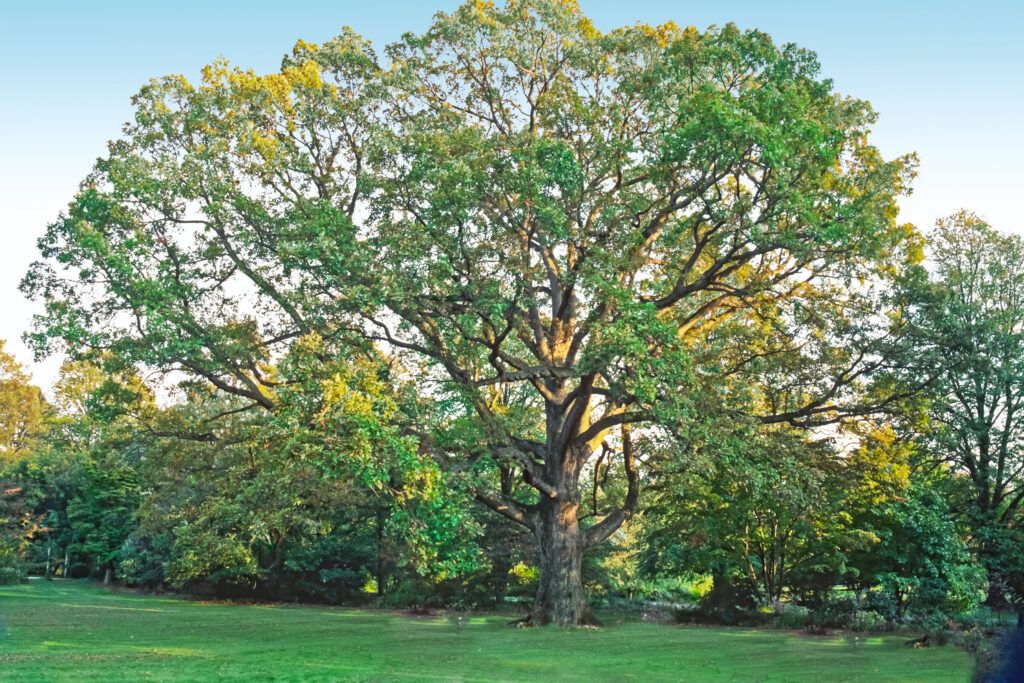
(Quercus alba)
Size: 50–80 feet high and wide
Where: Zones 3–8
Broad and round at maturity, this U.S. native with flat, lobed leaves and is adaptable to diverse growing conditions.
Highlight: Brilliant fall foliage
American Hornbeam
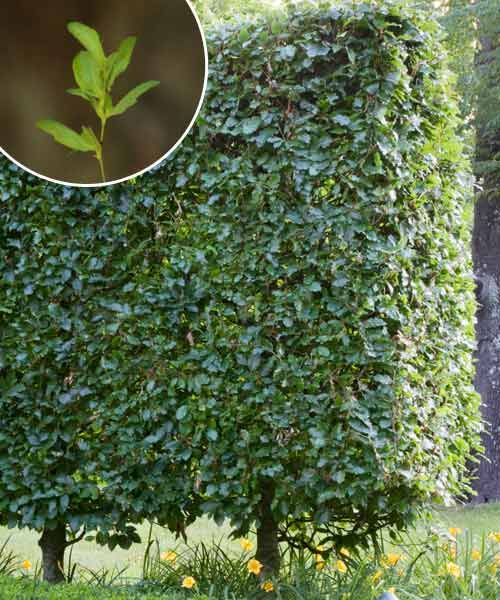
(Carpinus caroliniana)
Size: 20–35 feet tall and wide
Where: Zones 3–9
Named for the way its dense wood polishes like a horn, this tree forms a medium-sized, rounded canopy. Maximum growth is achieved in moist, acidic soil but performs remarkably well in less ideal conditions. Makes a fine street or lawn tree. The dark green leaves turn brilliant yellow to bright red in fall.
American Beech
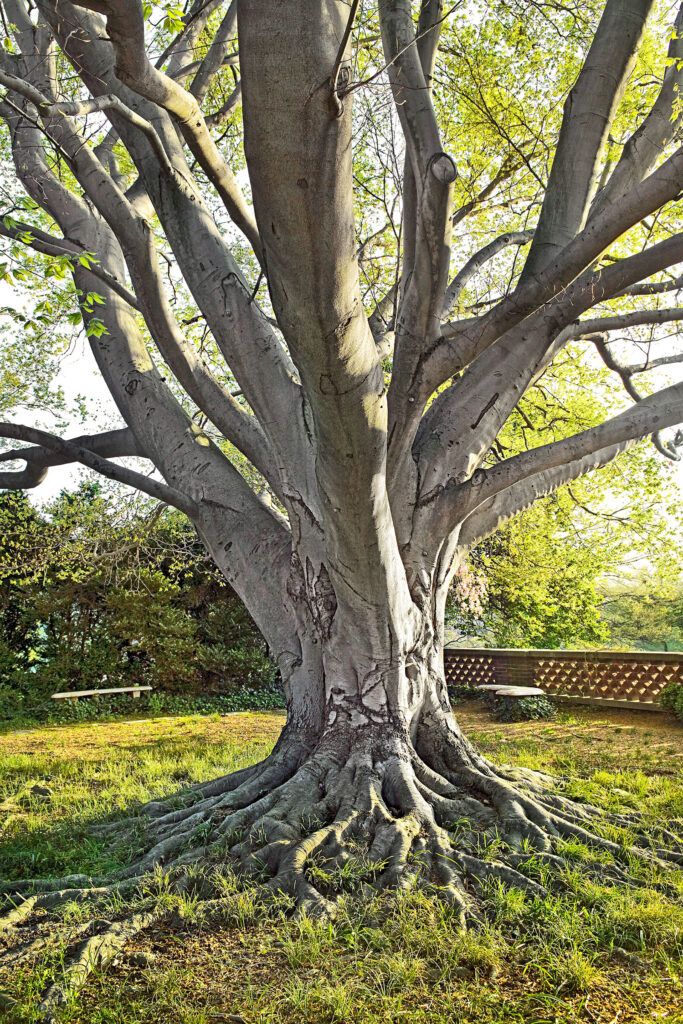
(Fagus grandifolia)
Size: 50–70 feet high, 40–70 feet wide
Where: Zones 4–9
Short trunk, wide-spreading crown, and shimmery foliage. Grows well in sun or shade.
Highlight: Smooth, light gray bark
Black Gum
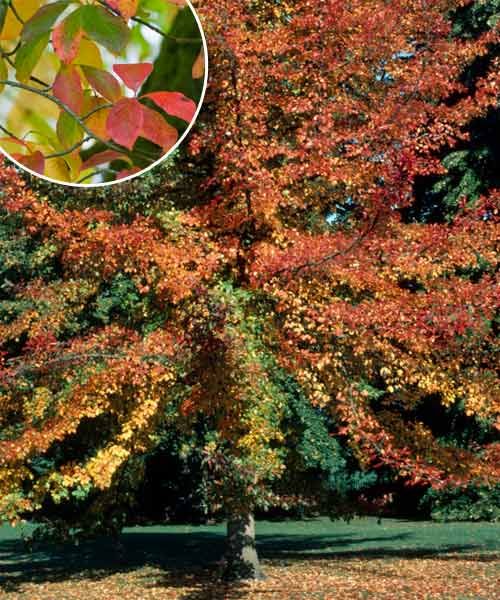
(Nyssa sylvatica)
Size: 30–50 feet tall, 20–30 feet wide
Where: Zones 3–9
Distinctly pyramidal in youth and becoming rounder as it matures. The dark grey bark is notably broken into thick ridges but it’s the fall foliage that makes this one desirable. Leathery leaves turn yellow, orange, red, or purple, all on the same branch in fall. Sour dark blue fruits, 1/2 inch wide, attract birds.
Red Maple
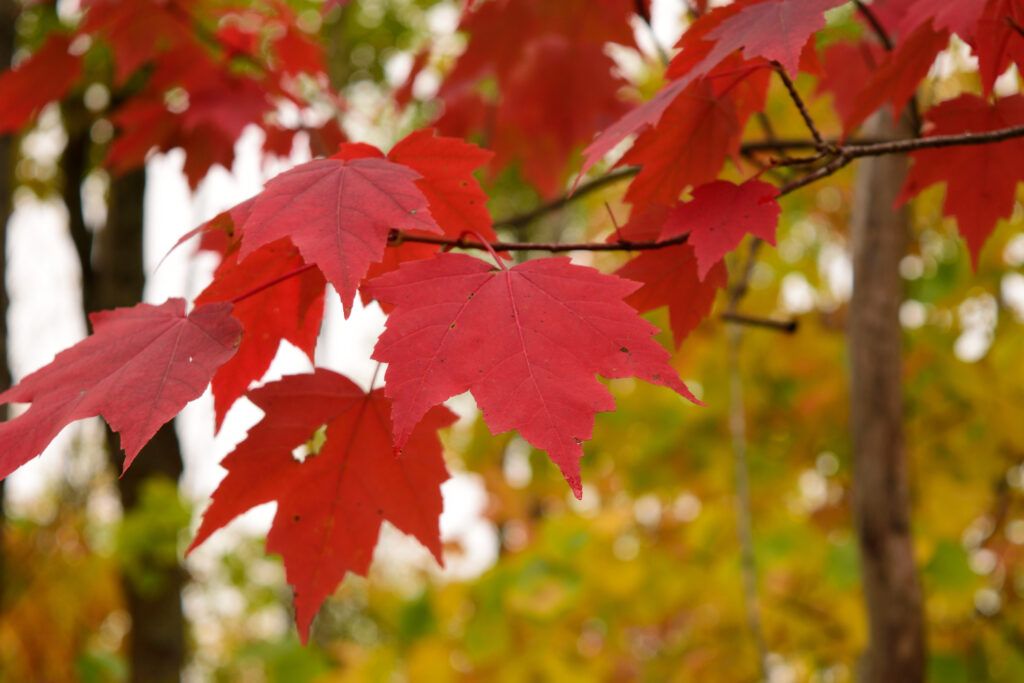
(Acer rubrum)
Size: 40–60 feet high, 30–50 wide
Where: Zones 3–9
Round crown at maturity, with red twigs and three-lobed, toothed leaves. Specific cultivars will grow best in different regions.
Highlight: Bright red fall foliage
Paperbark Maple
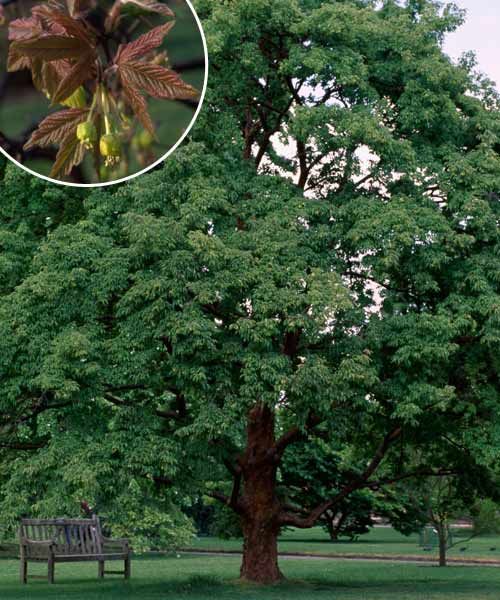
(Acer griseum)
Size: 20–30 feet tall, 15–25 feet wide
Where: Zones 4–8
As an element of the winter landscape, it’s truly a star. The rich cinnamon-hued bark peels to reveal smooth tan bark underneath and the leaves, dark bluish green atop and fuzzy underneath, turn brilliant red in the fall. Three-pointed leaves are blue-green on top and fuzzy underneath. In fall, they turn orange to red.
‘Valley Forge’ Elm
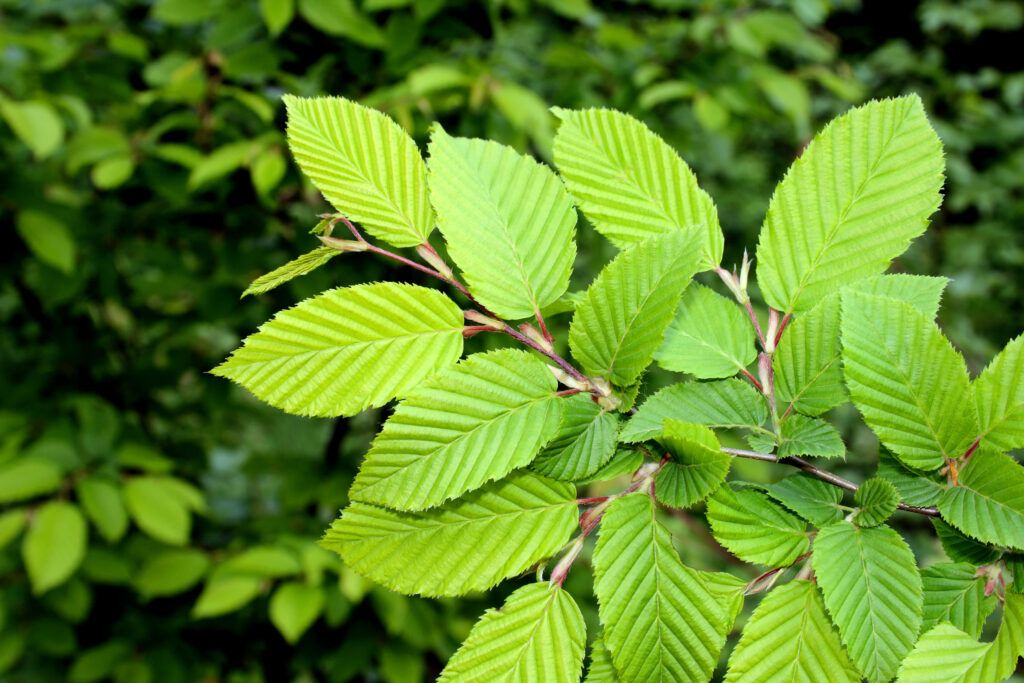
(Ulmus americana ‘Valley Forge’)
Size: 60–80 feet high, 30–50 feet wide
Where: Zones 2–9
Upright and vase-shaped with a full, dense canopy, this cultivar has been bred to resist Dutch elm disease.
Highlight: Toothy oval leaves
Lacebark Elm
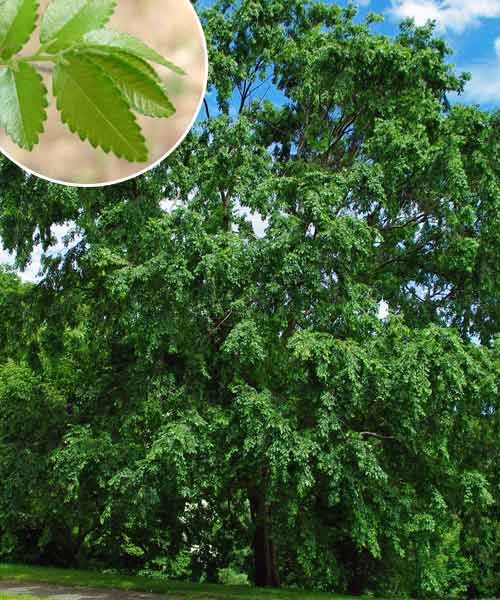
(Ulmus parvifolia)
Where: Zones 4–9
Size: 40–50 feet tall, 25–40 feet wide
Also known as Chinese elm, this variety has proven resistant to Dutch elm disease and elm leaf beetle. It has a rounded crown with uniform, finely textured branches. As the tree matures, pieces of bark peel away, creating an intriguing mottled look with gray, cream, orange, brown, and green. A great lawn or street tree, it is highly adaptable to extremes of soil and climate.
Southern Magnolia
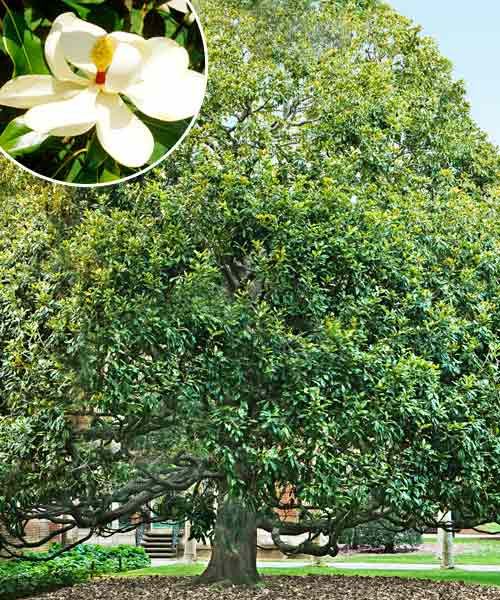
(Magnolia grandiflora)
Size: 60–80 feet high, 30–50 feet wide
Where: Zones 6–9
Pyramid-shaped with glossy, dark green leaves with matte brown undersides. Drought and heat tolerant once established.
Highlight: Fragrant spring flowers
Magnolia ‘Kay Parris’
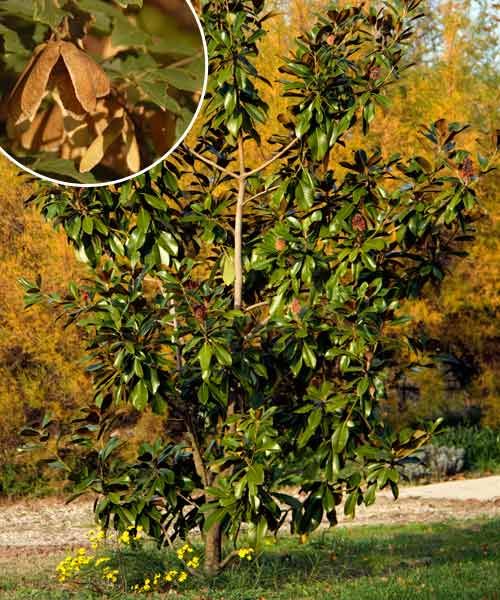
(Magnolia grandiflora ‘Kay Parris’)
Size: 20–30 feet tall and wide
Where: Zones 6–9
‘Kay Parris’ is a larger version of the very popular ‘Little Gem’ magnolia, long a substitute for the very large, Southern, classic magnolia. A beautiful compact magnolia ‘Kay Parris’ sports extremely glossy, bright green leaves with deep orange-brown fuzzy undersides and long flowering season make this a standout.
London Plane Tree

(Platanus x acerifolia)
Size: 70–100 feet high, 65–80 feet wide
Where: Zones 4–8
Massive stature, with wide-spreading branches at maturity.
Highlight: Olive-to-cream mottled bark
London Planetree ‘Morton Circle’
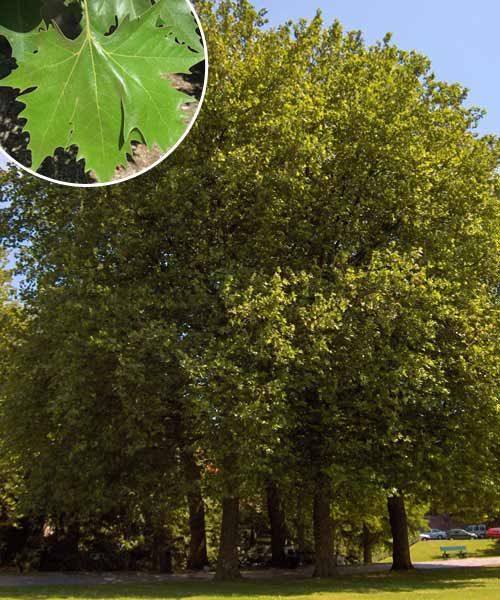
(Platanus x acerifolia ‘Morton Circle’)
Size: 60 feet tall and 45 feet wide
Where: Zones 4–8
‘Morton Circle’ is one of a group of new cultivars of this truly magnificent tree that due to its size, is most often seen in parks and large residential grounds. Pyramidal with a strong upright shape, this tree is vigorous and shares the same cream-to-olive colored mottled bark that’s a highlight of the winter landscape.
6 Shade Trees To Skip

They’re showy and fast growing, but these trees are a headache in the making:
1. Quaking aspen (Populus tremuloides): The most widely found tree in North America, its roots sucker aggressively, meaning it multiplies fast.
2. Norway maple (Acer platanoides): Invasive throughout the Northeast and Northwest, its strong, shallow surface roots crack and buckle sidewalks.
3. Sweet gum (Liquidambar styraciflua): (shown) Common in the Southeast, this nuisance has an invasive root system and litters yards and streets with spiky, sticky fruit fall through winter.
4. Mulberry (Morus alba, Morus rubra): Drops messy berries and is spread by birds throughout the eastern U.S.
5. Black walnut (Juglans nigra): Root secretions make surrounding soil toxic to many other plants.
6. Tree of heaven (Ailanthus altissima): This import produces seeds that sprout and crowd out other plants, it is invasive in all but Northern Plains states.
Strategic Shade Tree Placement for Energy Efficiency
Strategically placed shade trees can enhance your outdoor living spaces and improve energy efficiency. Proper planning and placement can make a significant difference in both aesthetic and functional value.
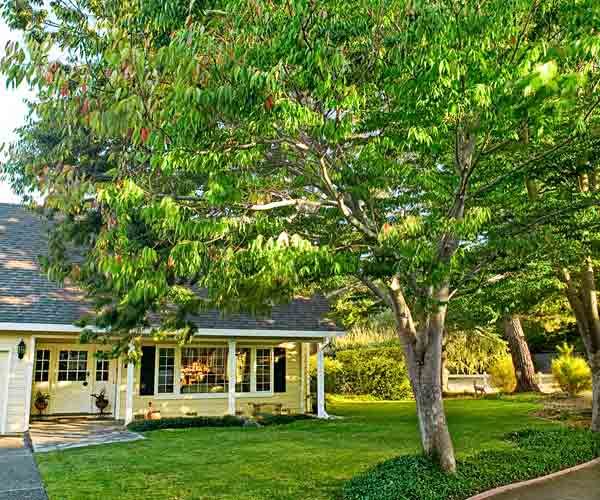
Plant deciduous trees on the south and west sides of your home to provide summer shade and allow winter sun. This placement can significantly reduce cooling costs and create a more comfortable outdoor environment.
Pests To Look Out For In Shade Trees
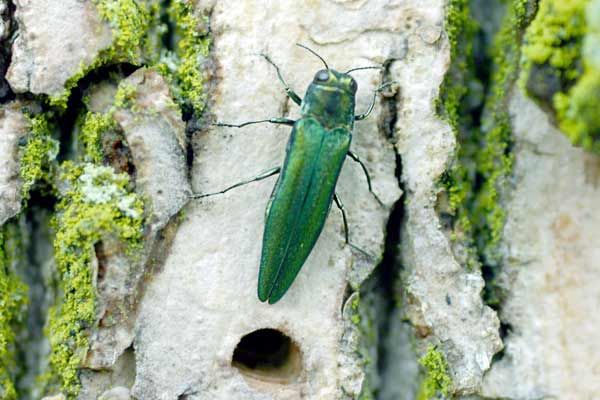
They chew, they suck, they bore; insects are among the worst scourges affecting deciduous trees. Some are species-specific, while others are less discriminating. Here’s how to address the damage.
Emerald Ash Borer
These 1/2-inch metallic-green beetles have larvae that feed on inner bark, eventually killing affected ash trees.
Fix: Have a pro apply systemic insecticide, even to healthy trees.
Asian Long-Horned Beetle
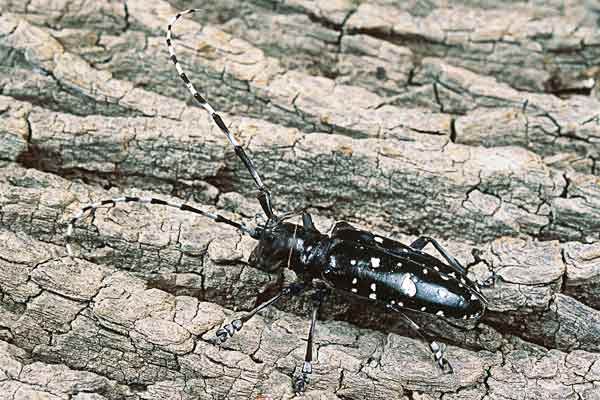
An inch-long black beetle with white spots, its larvae tunnel into maple, willow, and elm heartwood.
Fix: None—remove infested trees.
Gypsy Moths
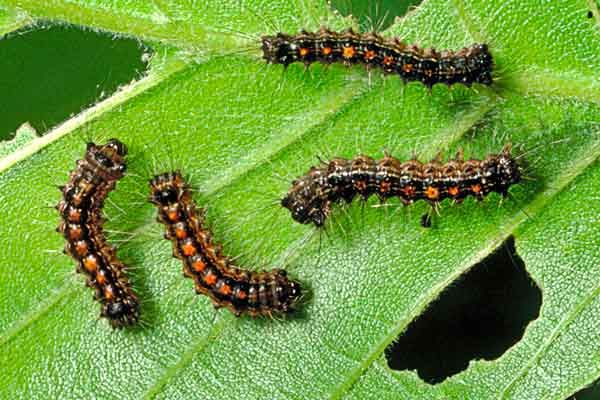
Dark, hairy spotted caterpillars up to 2 inches long denude the branches of many types of trees.
Fix: Too widespread to eliminate entirely. Aerial spraying with pesticides can lower the population.
Aphids
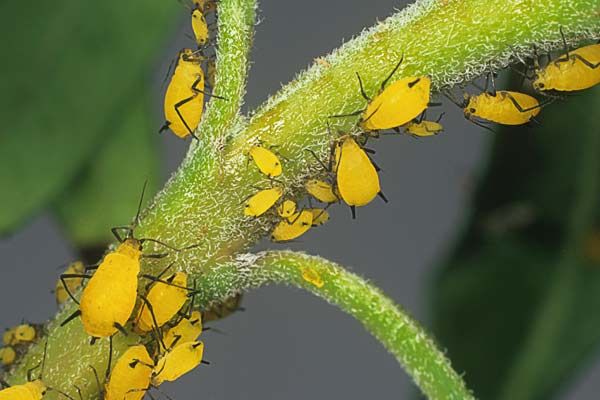
These tiny pests in different colors affect many tree species. Sucking damages leaves and honeydew-like secretions encourage sooty mold.
Fix: Ignore mild infestations, treat mold with a targeted pesticide.
Tent Caterpillars
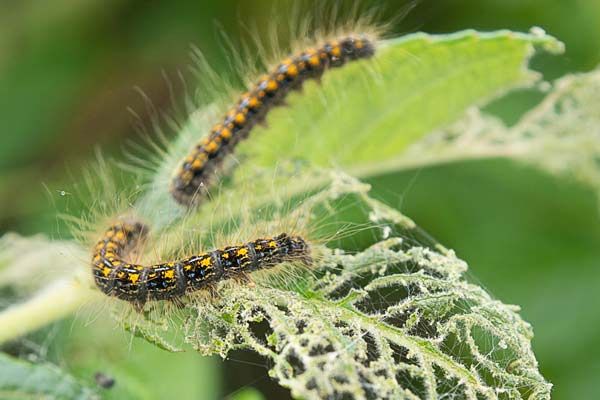
Fuzzy, 2-inch-long caterpillars infest many tree species. Feasting larvae strip trees bare.
Fix: Ignore, and let natural predators, including frogs, rodents, and birds, go at them.
Complementary Plants for Shade Gardens
Shade trees often get a bad rap among gardeners because their leaves block sunshine and their roots take up lots of water, leaving the soil around them a wasteland. But suitable companions do exist, such as these dry-shade dwellers.
Bleeding Heart
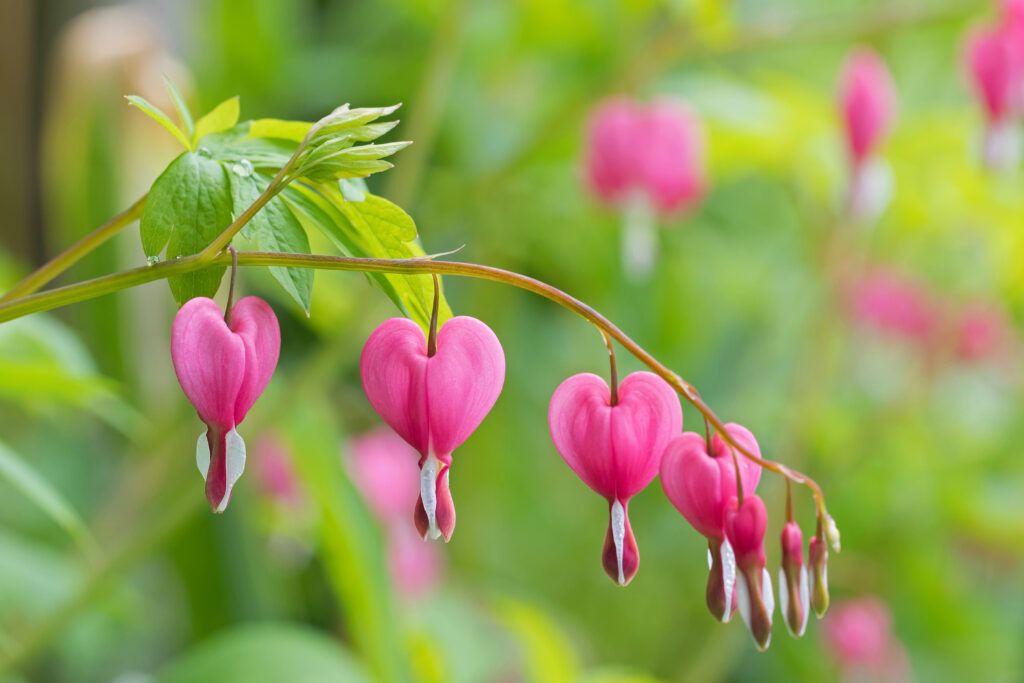
(Lamprocapnos spectabilis)
Where: Zones 3–9
Woodland perennial with fern-like foliage, showy heart-shaped pink to red flowers with white inner petals top graceful stems that rise 2 to 3 feet tall.
Foam Flower
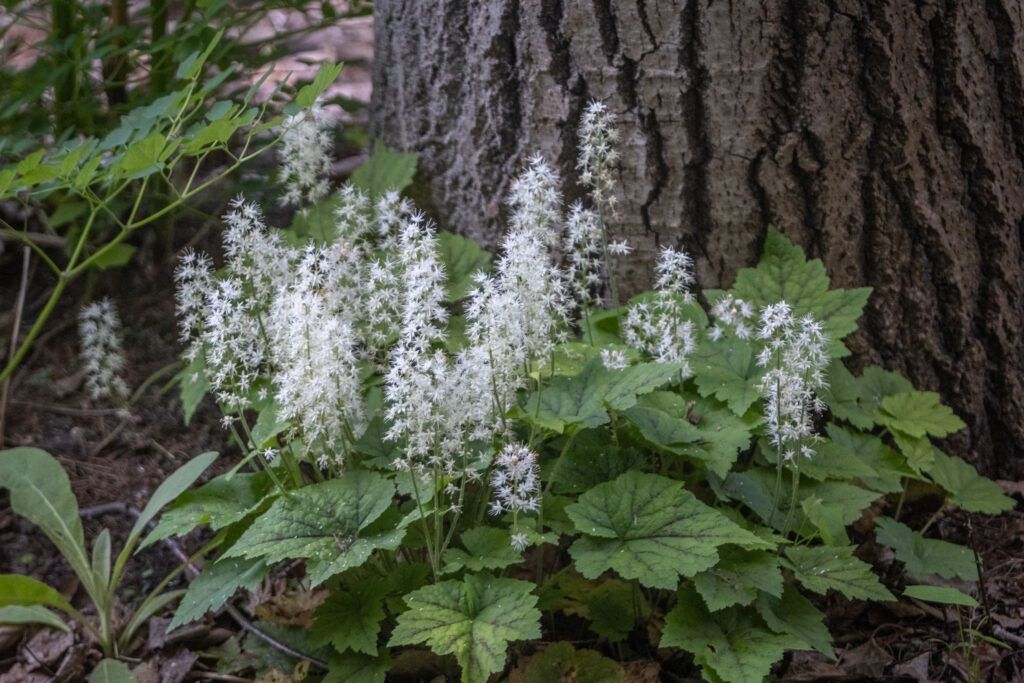
(Tiarella cordifolia)
Where: Zones 4–9
Native to the Eastern U.S., this clump-forming perennial spreads by runners, making a thick, 6- to 12-inch-high carpet of green. Small white flowers create the look of foam hovering over the leaves.
Hosta
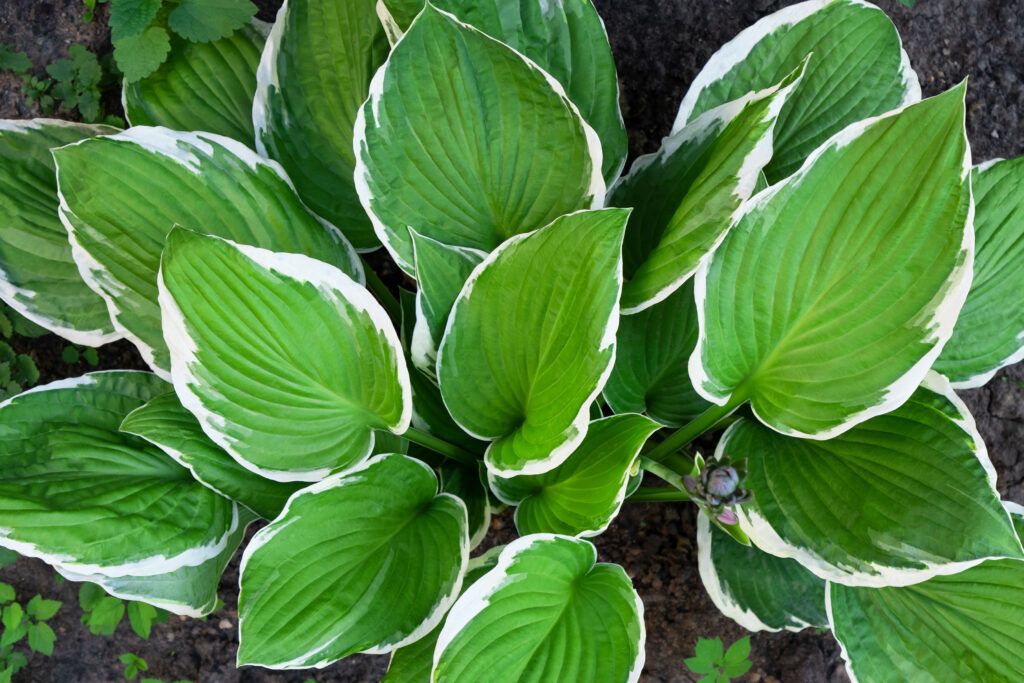
(Hosta)
Where: Zones 3–8
Well-mannered with showy foliage in blue-green to chartreuse, punctuated with spikes of cream to purple flowers. Grows even under black walnut trees. Size varies by variety.
Japanese Anemone
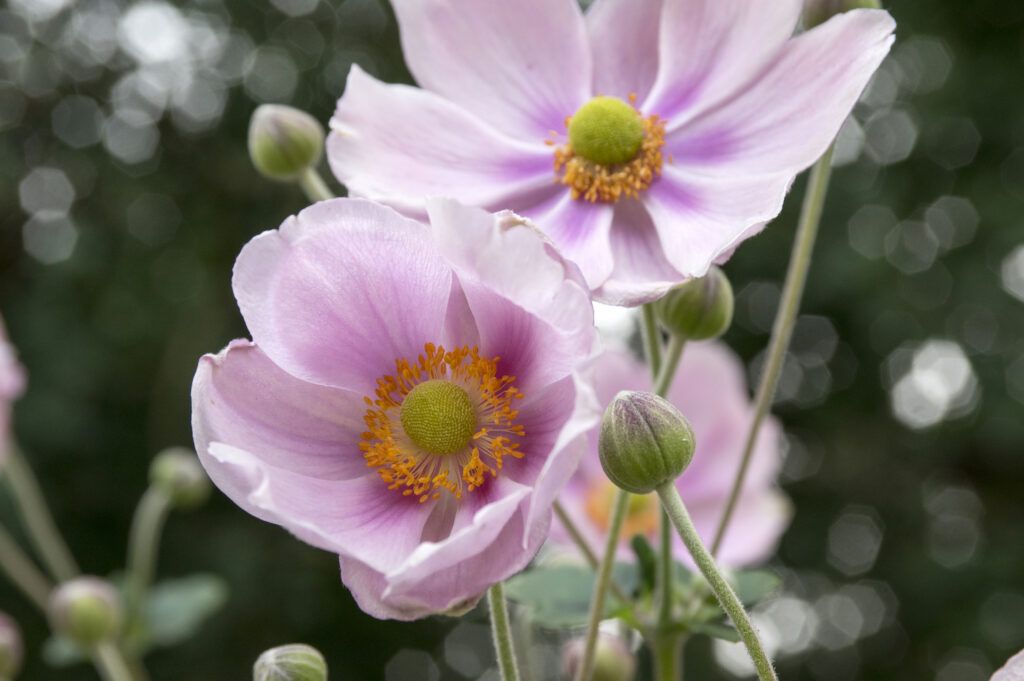
(Anemone hupehensis)
Where: Zones 4–8
Native to China, this perennial sends up a clump of leaves in spring, followed in late summer or fall by showy pink or white flowers on stems about 3 feet high that flutter in the wind.
Shade Tree Pruning 101
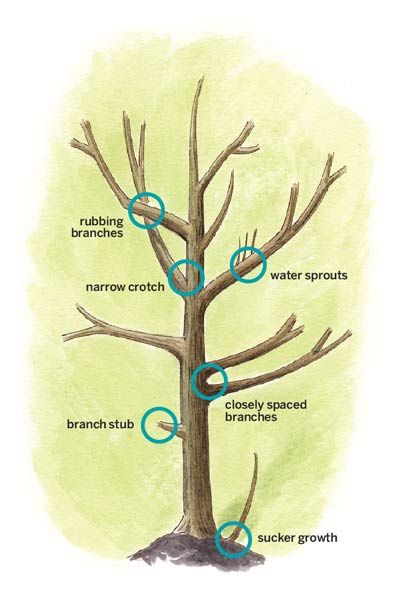
On a young tree, you can prune to create a balanced, well-spaced canopy.
Years one to five: Prune to encourage a single leader and cut out water sprouts and suckers. Remove branches that create a weak or narrow crotch or angle the trunk sharply. As the tree grows taller, remove branches on the bottom third of the trunk.
Five-plus years: Remove damaged, diseased, or crossed and rubbing branches. Prune to create better branch spacing.
To Cut or Not To Cut?
Consider the diameter of the branch with our graphic below.

The Long-Term Impact of Shade Trees
Shade trees are an investment in the future, offering benefits that increase over time. Their presence in your yard contributes to multiple positive outcomes that extend beyond your property.
Increasing Property Value
As we mentioned above, mature shade trees can significantly boost your property’s value. Well-maintained, healthy trees are attractive to potential buyers and can set your property apart in the real estate market.
Supporting Local Wildlife
Shade trees provide essential habitat for birds, insects, and small mammals. They offer nesting sites, food sources, and shelter, contributing to a healthy and diverse local ecosystem.
Contributing To Urban Canopy
By planting and maintaining shade trees, you’re contributing to the overall urban forest. This collective canopy helps mitigate the urban heat island effect, improves air quality, and enhances the livability of our communities.
Our Conclusion
Shade trees are invaluable assets to any landscape, offering a multitude of benefits, from environmental improvements to increased property value. By carefully selecting, properly planting, and diligently maintaining your shade trees, you’re making a lasting investment in your property and the environment.
